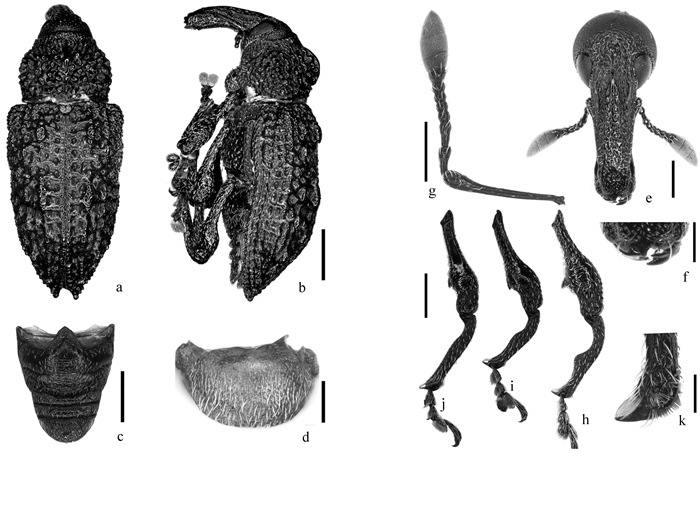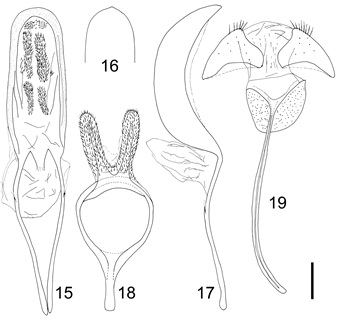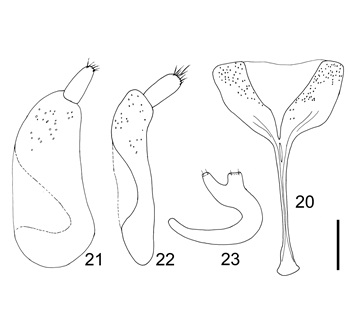-
近年来,在上海市进行园林病虫害调查时,发现了一种危害樟树Cinnamomum camphora的钻蛀性害虫(图 1a,图 1b),经鉴定,确认为香樟齿喙象Pagiophloeus tsushimanus Morimoto, 1982,为中国新记录种。该虫隶属于象虫科Curculionidae魔喙象亚科Molytinae树皮象族Hylobiini齿喙象属Pagiophloeus Faust,1892。正模与副模的产地均为日本对马岛,其中2头采集自樟树[1]。目前,该种还发现在福建福州有分布(图 1c)。为了便于识别此害虫,笔者给出了齿喙象属的鉴别特征,及香樟齿喙象的外部形态特征、雌雄外生殖器结构、分布信息及为害情况。
HTML
-
Pagiophlueus Faust, 1892: 195, 202; Heller, 1929: 12; Marshall, 1948: 399; Aslam, 1963: 61; Morimoto, 1982: 87, 1984: 326. Type-species: Rhynchaenus pacca Fabricius, by original designation.
Dysceroides Kȏno, 1933: 187; Kȏno, 1934: 225, 240; Voss, 1958: 43 (Fukien). Type-species: Dysceroides bipustulatus Kȏno, by original designation (type locality: Formosa).
-
额(图 2e)较喙基部宽。喙(图 2e和图 2f)长于宽,喙端部中央向前延伸成齿棒状凸起。触角(图 2g)柄节与索节长度相当;索节1长于2;棒节明显呈3节,左右不对称,棒节2和3明显向内倾斜。前胸背板眼叶显著(图 2b);基部呈明显二波状;腹板端部边缘强烈内凹。鞘翅(图 2a和图 2b)较前胸背板基部宽,不覆盖前胸背板基部,被简单鳞片。前足基节毗连;前足胫节基部外缘强烈弯曲,端部外缘平直,中部内缘强烈隆起;后足胫节外缘平直;胫节端刺尖锐,着生于内侧,起源于胫窝隆线;胫窝和跗窝的外缘鬃边均倾斜;跗节2横截,跗节5细长,爪离生、简单。雌虫第8腹板端部被稀毛,基部延伸成细长突起;生殖器具刺突,刚毛仅见于端部。
-
齿喙象属分布于中国、印度、缅甸、柬埔寨、越南、马来西亚、菲律宾、斯里兰卡、日本等地区[2-3]。其中,Pagiophlueus longiclavis Marshall是印度红木,如楝科Meliaceae洋椿Cedrela odorata,红椿Toona ciliata和紫椿Toona sureni等多种名贵树种根冠及立木的钻蛀性害虫[3-4]。
-
Faust[6]未明确表明属名Pagiophloeus的来源,且原始记述中的鉴别特征基本不适用于定义该属。本研究综合采用了Morimoto[1],Marshall[7]和Aslam[8]提出的属征。中文名的拟定根据其中1个特征,即喙端部中央的齿状锐凸,定名为齿喙象。
1.1. 属征
1.2. 分布与寄主
1.3. 中文名来源
-
Pagiophloeus tsushimanus Morimoto, 1982: 87(type locality: Azamo-Taterayama, Tsushima); Morimoto, 1984: 329.
-
香樟齿喙象在每鞘翅行间3与行间5共具4个大型颗粒状隆起。该种与台湾分布的Pagiophloeus bipustulatus(Kȏno, 1933)相近,但后者在每鞘翅上仅具2个大型颗粒,一个位于行间3近基部,另一个位于行间5翅坡[9]。
-
体长9.2~12.7 mm(平均11.2 mm)。虫体(图 1c,图 2a和图 2b)暗红棕色至黑色,触角、附节红棕色。体表稀被铁锈色和白色线状鳞片,腹面毛被比背面更长更密(图 2c)。体表刻点常覆盖浅黄色粉末状分泌物(图 1c)。头部(图 2e)刻点密,向端部渐稀,头顶中央略隆起。额平坦,两端等宽,中部略窄,中央具微小凹陷。喙粗壮,弯曲,与前胸背板等长,从基部向触角窝渐缩窄,之后扩宽,近端部两侧平行;背面刻点粗大,具5条不规则弯曲隆起,中央3条在基部聚合,侧面2条延伸至额;喙端部(图 2f)中央向前延伸成齿状凸起。触角(图 2g)柄节棒状,索节1~7节长度比为2.8:2.3:1.2:1.0:1.1:1.2,棒节3节,长椭圆形。前胸背板(图 2a和图 2b)两侧圆形,中部最宽,端部缩窄成领状,基部二叶状;背面中隆线显著,颗粒粗大,圆锥形。鞘翅(图 2a和图 2b)从肩向端部渐缩窄,端部具明显锐突。行纹刻点较大,行间窄,不规则,具1行显著颗粒;行间3具2个长椭圆形颗粒,分布位于基部1/3处和中部;行间5也具2个大颗粒,位于基部1/4处的较小,位于翅坡的较大。足(图 2h~j)粗壮,稀被铁锈色和白色线状鳞片;腿节显著膨大,端部皱纹明显;前足胫节内侧中央隆起显著,近三角形;中足胫节中央隆起较小;后足胫节在基部1/3处微隆起;各足胫节端距发达(图 2k)。腹板1中央略凹;腹板1~4刻点浅而稀,腹板5刻点密;腹板1~5节宽度比为3.8:1.8:0.8:1.0:1.9(图 2c)。臀板(图 2d)简单,密被白色毛状鳞片。雄性尾器特征见图 3a~e。
-
腹板1~2节中央隆起。雌性尾器特征见图 4a~d。其他特征类雄虫。检视标本:3♂4♀,上海市松江区辰山植物园,寄主:樟树,2012年6月,高磊采。
-
分布于中国上海市,中国福建省福州市;日本九州对马岛。
-
种加词tsushimanus来源于该种的模式产地Tsushima,即日本对马岛。中文名香樟齿喙象以该物种的寄主植物樟树(别名香樟)命名。
-
目前,该虫只发现危害樟树,由于它在上海和福建2地发现,其模式产地对马岛与华东区地理区系类似,因此推测该虫应该是一种本地物种。近年来由于樟树的广泛栽植而成为一种重要害虫。该虫在上海地区首次发现于2006年,而后为害日趋加重。2012年4月,在上海外环线樟树林带发生严重,樟树树干受其钻蛀为害(图 1a和图 1b),发生严重区域的株危害率超过90%,单株有虫数最高63头,受害严重时樟树生长势衰弱,树皮爆突。初步观察结果表明:该虫在上海地区1年发生1~2代,以幼虫在樟树主杆和侧枝的韧皮部与木质部之间越冬,5月末始见成虫,成虫羽化高峰期在6月中下旬-8月上旬,8月中旬后以幼虫为主,9月下旬发现零星成虫、蛹。初步防治试验表明:4月下旬对越冬幼虫采用三唑磷50,100倍稀释针对树干喷雾,1周后调查幼虫死亡率分别为80%和90%。

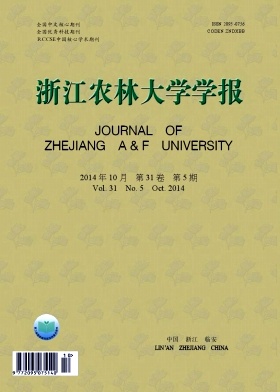


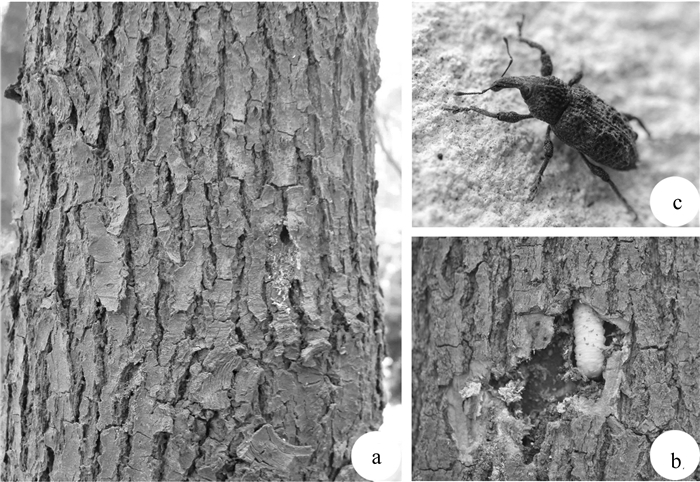






 DownLoad:
DownLoad:
